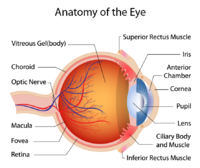Retinal vasculature
Project presented by Leïla Ouhamma & Audran Feuvrier
Supervised by Daniel Krefl
Introduction
The Retinal vasculature (RV) refers to the blood vessels that supply the retina, which is the thin layer of tissue located at the back of the eye.
It is responsible for detecting light and sending visual information to the brain.
The retinal vasculature includes both arteries and veins, which branch out from the optic nerve and supply oxygen and nutrients to the retina.
The advantage in working with RV
There is a significant interest in working with RV. These blood vessels can provide important diagnostic information about the health of the eye and the body as a whole. Changes in the RV can be a sign of various medical conditions, including diabetes, hypertension, and cardiovascular disease. Therefore, the examination of the retinal vasculature is an important part of a comprehensive eye exam and can help detect and monitor these conditions.
Moreover, obtaining images of the retinal vasculature can be relatively easy and cost-effective with modern technology, such as during a routine exam at the ophtalmologiste. There are various methods known to be non-invasive and generally well-tolerated by patients.
Deep Learning: Revealing Insights through Retinal Vasculature Embedding
Our aim is to use deep learning to embed retinal vasculature images into a lower dimensional space, enabling us to gain insights or make predictions.
To do so, we will first build DL algorithms to produce a latent space to detect and highlight specific features.
Then, the results can be used to learn about the behavior of the algorithm, use this latent space for potential inference on diagnostics and genetic correlation.
Milestones of the project
1. Data pre-processing
In the case of retinal imaging, images are pre-processed to improve image quality and to extract relevant features.
Therefore, we went through several steps :
- Resizing: The first step is to resize the image to a standard size. This is done to ensure that all images have the same dimensions and to reduce the computational load during subsequent analysis.
- Color changes: The next step was to play with the colors of our images because it can be relevant in order to verify if there are some differences in the results we obtain with our machine. We did a grey scaling standardization. We also prepared pictures containing only the veins and arteries to train our model on each structure because maybe it could show unexpected features which could affect the accuracy of subsequent analysis.
- Cropping: Another step is to crop the image. This involves shifting the image to get rid of non relevant information.
2. Build and train the model
When the data is ready, we define the auto encoder we want to use. An autoencoder is a type of artificial neural network architecture that learns a compressed representation of data by mapping it to a lower-dimensional latent space and then reconstructing the original data from this lower-dimensional representation. In the context of RV images, an autoencoder can be used for unsupervised feature learning.
We also base our machine training on a Convolutional Neural Network (CNN) model. It uses convolution to extract image features, pooling to reduce dimensionality, and deconvolution/upsampling to reconstruct and enhance details.
We will use a U-net architecture for segmentation, which combines the two previous concepts to divide each image into several distinct regions, so that they can be analyzed separately.
3. Analysis using the embeddings
